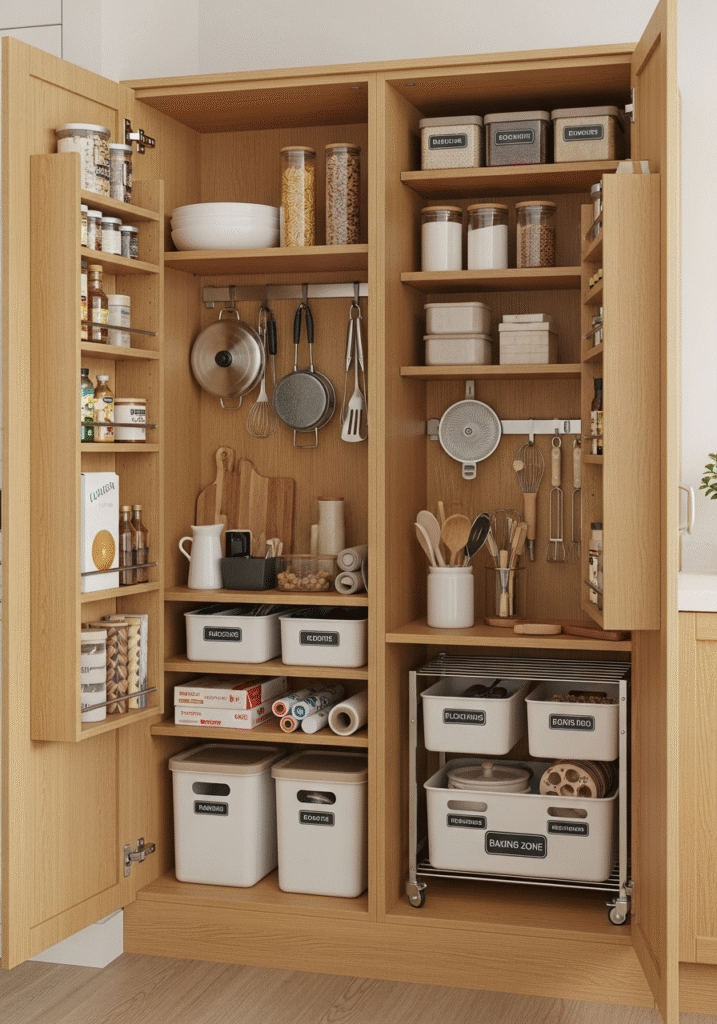Introduction
A well-organized kitchen cabinet system isn’t just about aesthetics—it’s a practical investment in your daily life. From rushed weekday breakfasts to relaxed weekend dinners, a streamlined cabinet layout can make every task in the kitchen faster, easier, and more enjoyable. When your kitchen is tidy and thoughtfully arranged, you’re not only saving time and reducing stress, but you’re also creating a safer and more hygienic cooking environment. No more digging through cluttered shelves or accidentally buying duplicates of spices and dry goods—an organized space helps you keep track of what you have and what you need, significantly cutting down on food waste.
Beyond functionality, a clean and efficient kitchen can actually inspire you to cook more often, try new recipes, and embrace healthier eating habits. It’s a subtle but powerful motivator: when your space feels manageable, your mind feels clearer, and tasks that once felt like chores start to feel satisfying. Plus, if you enjoy browsing kitchen blogs, watching organization videos, or clicking on curated product suggestions (including those helpful AdSense ads!), a well-organized cabinet system makes you feel like you’re part of that same world—tidy, intentional, and in control.
This guide takes you step-by-step through the process of organizing your kitchen cabinets, from decluttering and categorizing items to selecting the right containers and maintaining your new system. With these ten simple yet transformative strategies, you’ll create a kitchen that’s not just more functional, but more enjoyable to live and cook in. Whether you’re working with a tiny galley kitchen or a spacious chef’s layout, the principles in this guide will help you make the most of your space—and maybe even inspire a few clicks along the way.
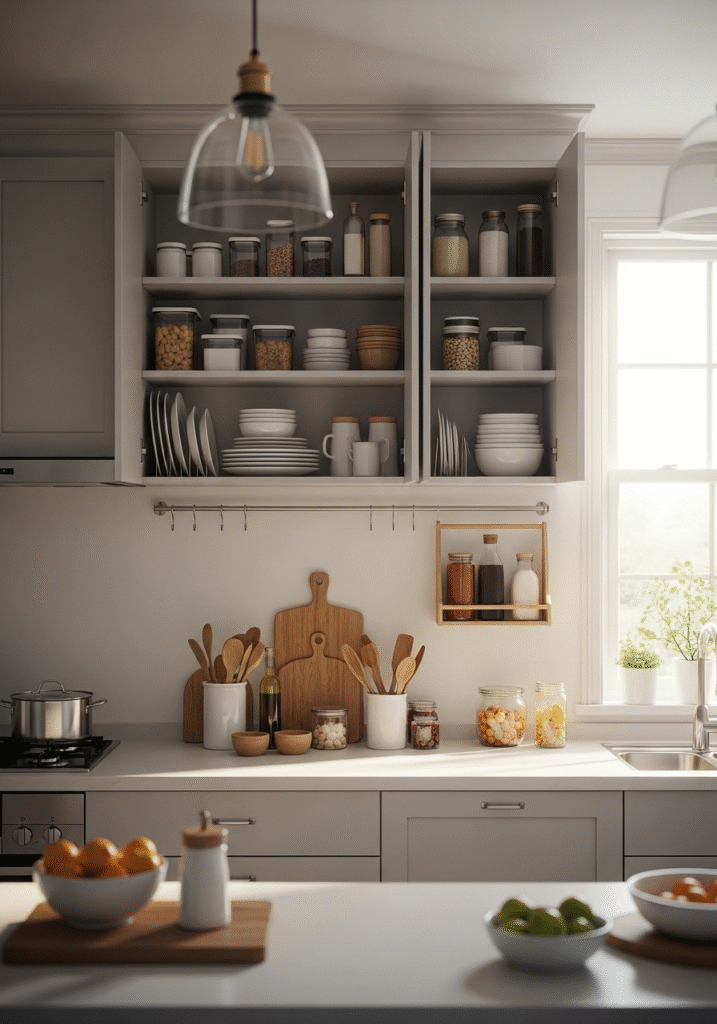
Step 1: Plan and Empty
Before you can transform your kitchen cabinets into a functional, beautiful system, you need to begin with a clean slate. That means removing everything—yes, everything—from your cabinets, drawers, and shelves. It might seem like a big task at first, but this step is crucial. Trying to organize around clutter only masks the problem. By emptying your cabinets completely, you gain a clear understanding of what you actually own, what you use, and what’s simply taking up space. This clarity is the first major step toward creating a system that works for you and your lifestyle.
Why This Step Matters
Taking the time to plan your organization process—and fully empty each space—helps prevent burnout and decision fatigue. It’s easy to underestimate how much is hidden behind closed cabinet doors. Starting fresh allows you to handle each item with intention, whether that means keeping, donating, or tossing it. Plus, it gives you the perfect opportunity to deep-clean the cabinet interiors, getting rid of crumbs, spills, and dust that may have gone unnoticed.
What You’ll Need:
- A dedicated block of time (like a free weekend or a quiet weekday morning)
- Trash bags for expired food, broken items, and things you no longer need
- Donation boxes for gently used kitchenware or duplicate items
- Cleaning supplies, including cloths, sponges, and an all-purpose cleaner
- Sticky notes or bins to sort items by category or zone (e.g., baking, snacks, spices)
How to Do It:
Start with just one cabinet or drawer at a time. This approach keeps things manageable and helps maintain your motivation. As you empty each space, sort items into broad categories—this makes it easier later on when deciding where and how to put them back. Designate a space on the counter or floor for each zone: for example, a pile for baking tools, one for cooking oils, another for everyday dishes, and so on.
Don’t worry if your kitchen gets messy during this phase—that’s part of the process. What matters is that everything comes out so you can reset your space with intention.
Quick Progress Checklist:
- ✅ Upper cabinets emptied and sorted
- ✅ Base cabinets and drawers emptied
- ✅ All items placed on a clean surface or the floor for sorting
By working methodically, you avoid getting overwhelmed and maintain forward momentum. Completing this first step sets the tone for the rest of your kitchen transformation. It’s not just about cleaning out cabinets—it’s about clearing space for better habits, better meals, and a better daily flow.
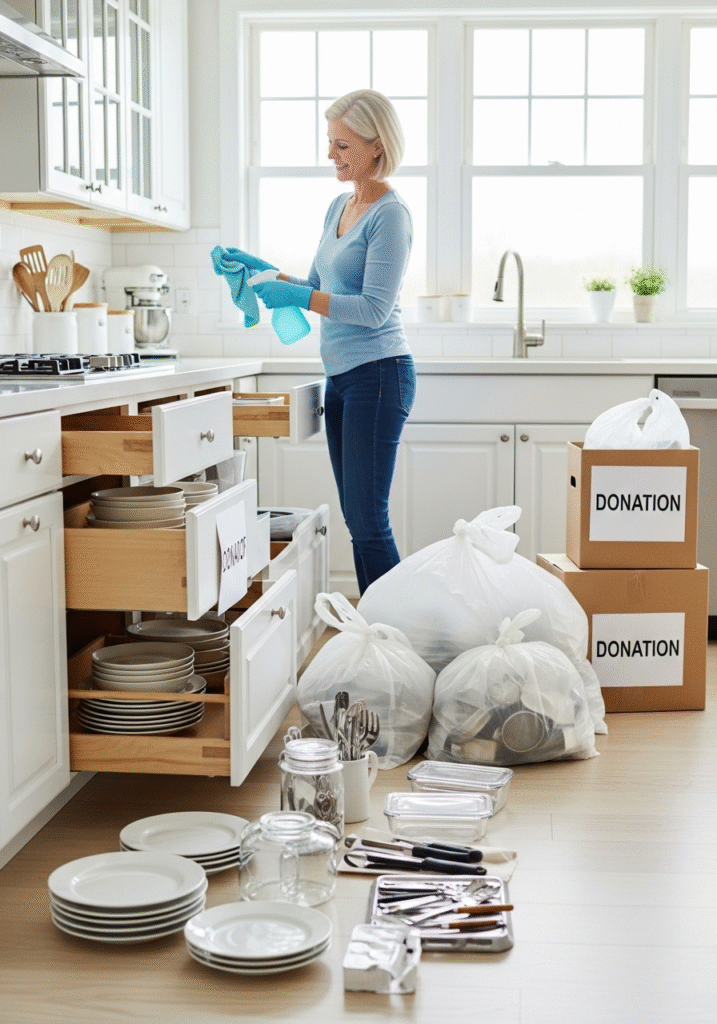
Step 2: Sort and Categorize
Now that every cabinet and drawer has been emptied, it’s time to bring order to the chaos. Sorting and categorizing your kitchen items is one of the most crucial parts of the organizing process. Without it, you risk putting things back in random places—and before you know it, your cabinets will be cluttered all over again.
This step is all about clarity: understanding what you have, how often you use it, and where it makes the most sense to store it. A well-thought-out sorting system ensures that the items you reach for daily are always within arm’s reach, while seasonal or rarely used tools don’t hog valuable space.
Start with Frequency of Use
The most effective way to begin sorting is by thinking about how often you use each item. Create three basic groups:
- Everyday Items – Plates, cups, utensils, and pans you use daily or almost daily.
- Occasional Use – Holiday dishes, baking tools, large serving bowls, or specialty gadgets.
- Rarely Used – Ice cream makers, seasonal cookie cutters, or backup appliances you forgot you even owned.
By identifying frequency, you’ll know which items deserve prime cabinet real estate—and which can be stored in harder-to-reach spots.
Then Sort by Type and Function
Next, group items based on what they do or how they’re used. This makes the process of returning items to cabinets far more intuitive. Here’s a helpful breakdown:
- Dinnerware & Drinkware – Plates, bowls, mugs, glasses
- Pots & Pans – Saucepans, skillets, stockpots, lids
- Food Storage – Plastic or glass containers, matching lids
- Baking Supplies – Mixing bowls, measuring cups, muffin tins, rolling pins
- Pantry Items – Dry goods, canned foods, spices, snacks
- Cleaning Supplies – Dish soap, scrubbers, sponges, trash bags
- Small Appliances – Toasters, blenders, mixers, food processors
Lay out each group so you can see exactly what you have. You’ll probably notice duplicates you didn’t know you owned, or items that no longer serve a purpose.
Declutter As You Go
Decluttering should happen during sorting—not afterward. Be ruthless, but realistic. Here are a few decluttering guidelines to help:
- Toss chipped plates, cracked Tupperware, or melted spatulas.
- Donate duplicate mixing bowls, extra mugs, or unused appliances.
- Evaluate necessity by taking a quick photo of your kitchen setup. Seeing it visually can reveal what’s excessive or redundant.
- Ask yourself: “Have I used this in the past year?” If not, it’s probably safe to let go.
Bonus Tip: Use Labeled Bins or Zones
While sorting, consider using temporary bins or containers with sticky notes to keep things categorized. This makes reloading your cabinets in the next steps even easier.
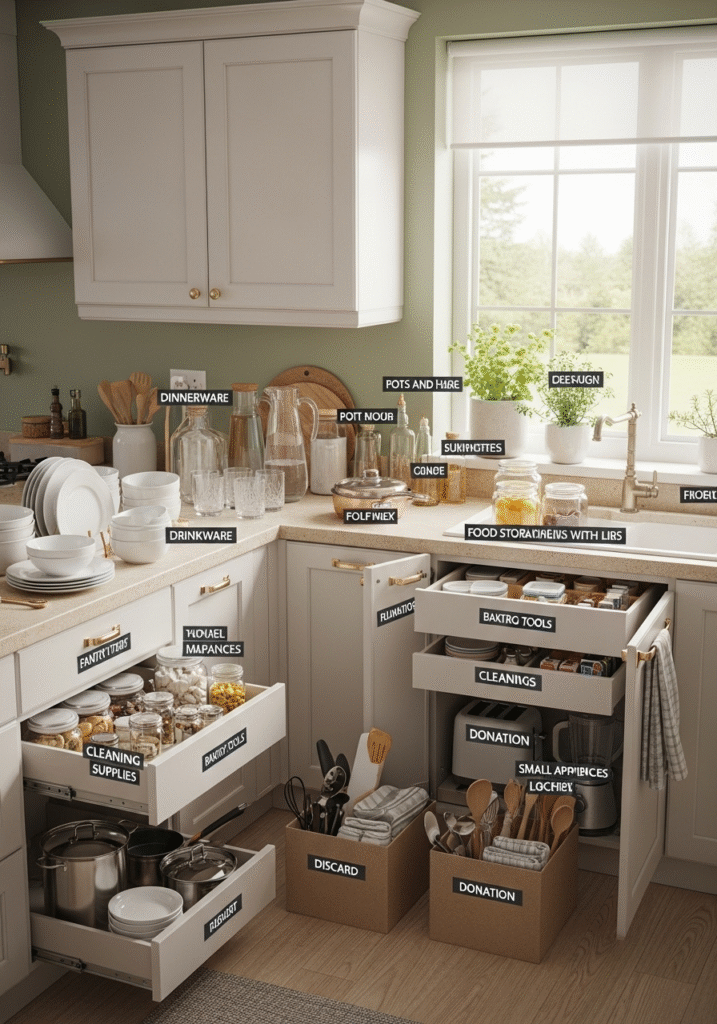
Step 3: Clean Inside
With your cabinets and drawers finally emptied and items sorted, now is the perfect opportunity to give the inside of your storage spaces a deep, thorough clean. Let’s face it—most people rarely clean inside their cabinets unless there’s a spill or an obvious mess. But over time, dust, crumbs, sticky residues, and even pests can accumulate unnoticed. This step transforms your kitchen storage from just “emptied” to truly refreshed and ready for a better system.
Why It Matters
Cleaning the interiors of your cabinets isn’t just about appearance. It’s about hygiene, safety, and giving yourself a fresh, clean foundation to build upon. After all, you’re about to put your most-used kitchen tools, dishes, and food items back in there—you want that space to feel clean and cared for. It also makes it easier to spot potential maintenance issues like water damage, mold, or pests before they become bigger problems.
How to Do It Right
Start with the top cabinets, and work your way down to the base cabinets and drawers. Here’s a simple process to follow:
- Wipe all surfaces with a clean cloth or sponge and a gentle cleaning solution. A mix of warm water and a mild all-purpose cleaner works well. If you prefer a natural approach, a solution of white vinegar and water is both effective and eco-friendly.
- Pay attention to corners and edges, where crumbs and dust tend to settle.
- Let everything dry fully before replacing any items. Use a clean towel or allow cabinets to air-dry.
- For an extra layer of protection and easy future cleaning, consider adding adhesive shelf liners or removable, wipeable mats. These help prevent scratches and can be pulled out and cleaned in minutes.
Natural Cleaning Bonus Tip ✨
For a refreshing, chemical-free cleaner that also disinfects:
- Mix equal parts white vinegar and water
- Add a few drops of lemon essential oil or fresh lemon juice for a natural degreaser and pleasant scent
This combo cuts through grease, removes odors, and leaves a streak-free shine on most cabinet surfaces—especially great for glass or glossy finishes.
Don’t Forget the Hardware
While you’re at it, give your cabinet knobs, handles, and hinges a quick clean too. These high-touch areas often collect grime and grease over time, especially near cooking areas.
Taking the time to clean inside your cabinets not only makes your kitchen feel brand new—it sets a cleaner, calmer tone for how you’ll maintain it moving forward. You’ve done the hard part by emptying and sorting; this step brings that sense of order full circle and prepares your space for a thoughtful, intentional
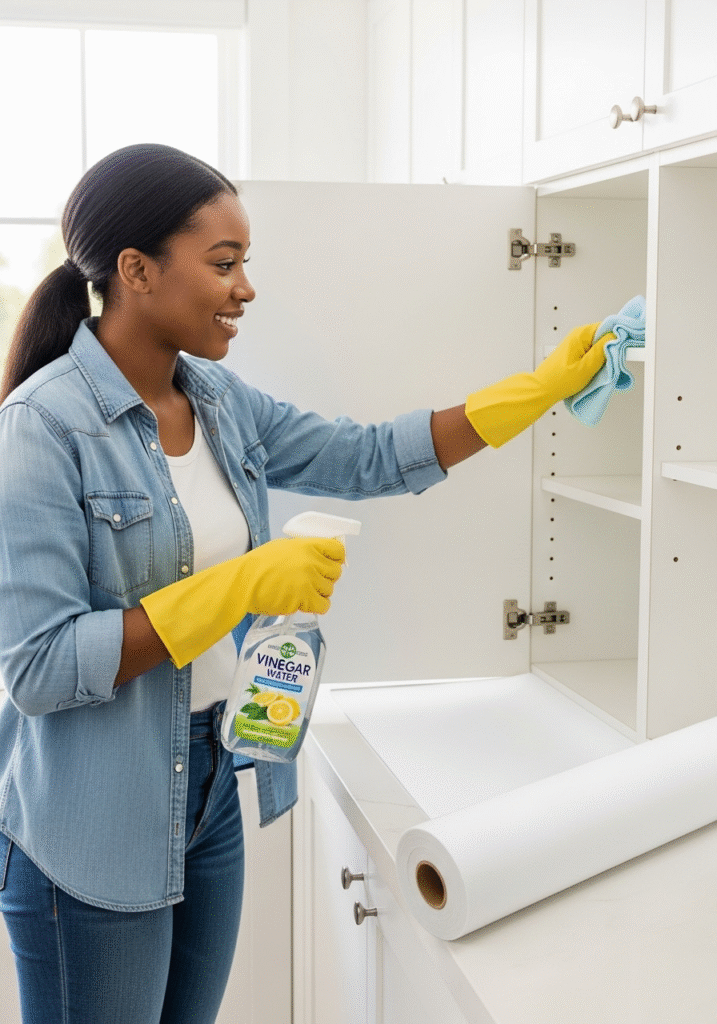
Step 4: Define Zones
Once your cabinets are empty, cleaned, and your items sorted, it’s time to think strategically about where everything should go. Defining clear kitchen zones based on function is one of the smartest ways to boost efficiency and make your cooking and cleaning routines flow effortlessly. Instead of a random mishmash of dishes, pots, and pantry goods scattered everywhere, a well-zoned kitchen means the tools and ingredients you need are always within easy reach of where you actually use them.
Why Zoning Matters
Imagine grabbing a pot from the cabinet directly beside your stove or having all your baking tools gathered near the counter where you mix ingredients. Defining zones saves time, reduces unnecessary walking, and minimizes kitchen chaos—especially during busy meals. It also makes cleanup faster because cleaning supplies and trash bags are close to where messes happen.
Common Kitchen Zones and Where to Place Them
Here’s a breakdown of typical zones, with tips on the best locations for each:
- Daily Prep Zone:
This is your go-to space for quick meal prep—think chopping veggies, making sandwiches, or assembling breakfast. Ideally, this zone should be close to your main countertop, with knives, cutting boards, mixing bowls, and frequently used utensils nearby. It’s where efficiency meets ease. - Cooking Zone:
Centered around the stove and oven, this zone includes pots, pans, cooking utensils, spices, oils, and any tools needed for active cooking. Keeping these items within arm’s reach of your hot zones drastically reduces extra steps and frustration during meal preparation. - Baking Zone:
Baking often requires different tools and ingredients than everyday cooking. Group your baking pans, measuring cups, mixing bowls, spatulas, and ingredients like flour, sugar, and baking powder near your designated mixing station or countertop. Having a dedicated space for baking helps keep specialty ingredients and gear organized and separate from general cooking supplies. - Storage Zone:
This area is for dry goods, canned items, snacks, and food containers. It’s often best placed in a pantry or a set of deep cabinets that are easy to access but don’t interfere with your active cooking and prep areas. - Cleaning Zone:
Typically found under the sink or near the dishwasher, this zone houses your dish soaps, scrubbers, sponges, trash bags, and cleaning sprays. Keeping these items together and near where dishes are washed makes cleanup faster and more organized. - Specialty Items Zone:
For gadgets and tools you use rarely—like ice cream makers, holiday platters, or large party trays—designate a separate zone in less accessible cabinets or higher shelves. This keeps your everyday kitchen clutter-free while still giving these items a home.
Key Point: Logical Placement Is Everything
The goal is to place zones where they naturally belong in relation to how you move through your kitchen. When your storage layout mirrors your cooking workflow, you reduce extra steps, avoid frustration, and create a space that feels intuitive and inviting. For example, don’t store pots and pans across the kitchen from your stove, or keep cleaning supplies far from the sink. Small changes in where you place things can have a huge impact on your overall kitchen experience.
By thoughtfully defining your kitchen zones now, you set yourself up for a smoother, more enjoyable cooking and cleaning routine every day. This organization strategy makes your kitchen work with you, not against you—a key to creating a space that feels effortless and welcoming.
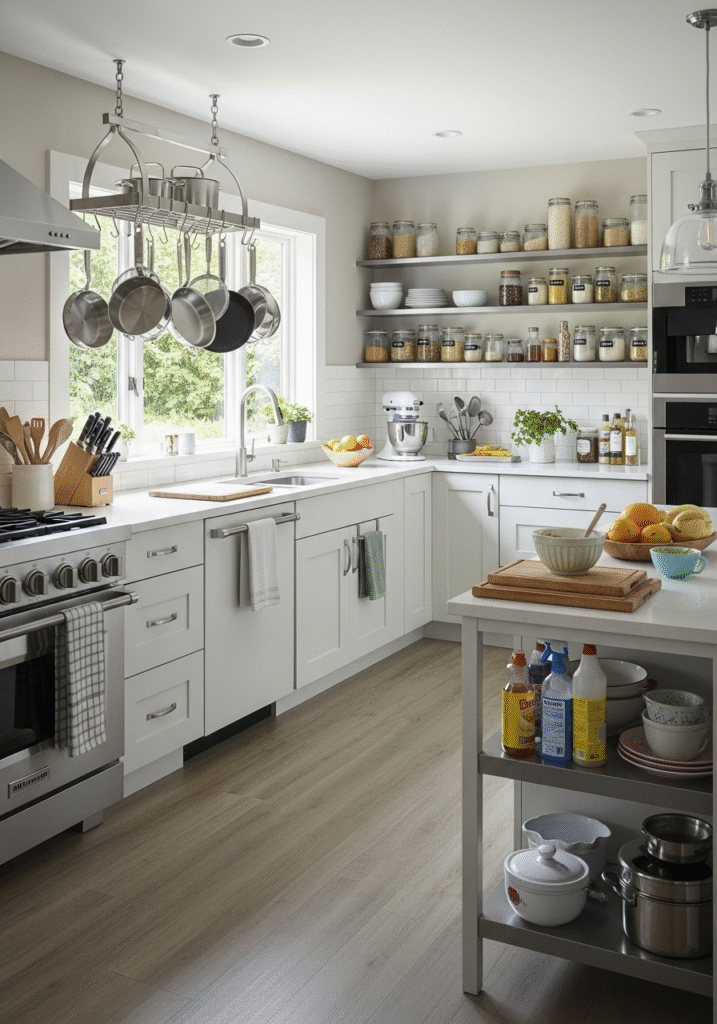
Step 5: Choose the Right Storage Tools
After defining your kitchen zones and sorting your items, the next game-changing step is to equip your cabinets with smart storage tools that maximize space, improve accessibility, and keep everything neatly in place. Investing in the right storage solutions tailored to your kitchen layout can completely transform how your cabinets function—turning cramped, hard-to-reach spaces into highly efficient, organized zones where everything has its place.
Why Storage Tools Matter
No matter how well you sort or zone your kitchen, the right storage accessories can multiply your usable space and simplify everyday tasks. They allow you to utilize vertical space, prevent items from toppling over, and make even the deepest cabinets or narrowest drawers easy to navigate. When you pick tools that fit your cabinets’ dimensions and your personal needs, you’ll save time hunting for things and avoid frustrating clutter build-up.
Must-Have Storage Tools and How to Use Them
- Shelf Risers:
These simple platforms double your vertical storage by creating an additional shelf inside your cabinets. Shelf risers work especially well for stacking plates, bowls, or mugs without worrying about fragile stacking or wasted space above. - Lazy Susans:
A classic for a reason—Lazy Susans spin to provide easy access to small items. They’re perfect for organizing spices, oils, condiments, or pantry corners where items tend to get pushed to the back and forgotten. - Drawer Dividers:
Keep utensils, gadgets, and tools orderly and easy to find with adjustable drawer dividers. These help separate forks from knives, measuring spoons from peelers, and prevent clutter from accumulating inside drawers. - Pull-Out Trays or Baskets:
Deep cabinets often become “black holes” where things get lost. Installing pull-out trays or baskets transforms these spaces into easily accessible storage zones, allowing you to slide out contents like canned goods, pots, or cleaning supplies without heavy digging. - Clear Bins and Containers:
Use clear, labeled bins to group similar items together—snacks, baking supplies, cleaning tools, or pantry goods. Transparency means you can see contents at a glance, which helps you keep track of inventory and avoid buying duplicates. - Tension Rods and Hooks:
These versatile tools make excellent use of cabinet door interiors. Attach tension rods inside cabinet doors to store pot lids upright or use hooks for hanging wraps, scissors, or lightweight tools, keeping these essentials out of the way but within reach.
Custom Fit Is Key
One of the most important factors in choosing storage tools is to measure your cabinets carefully. A well-fitting shelf riser or pull-out tray works far better than a one-size-fits-all option that wobbles or wastes space. Consider the height, width, and depth of your cabinets, and choose adjustable or modular solutions when possible to accommodate different-sized items.
Benefits Beyond Organization
Beyond just neatness, these storage tools help preserve your kitchen items by preventing damage from stacking or overcrowding. They also encourage better habits by making it easier to maintain order long-term. Once you’ve invested in a system that works, tidying up becomes less of a chore and more of a quick reset.
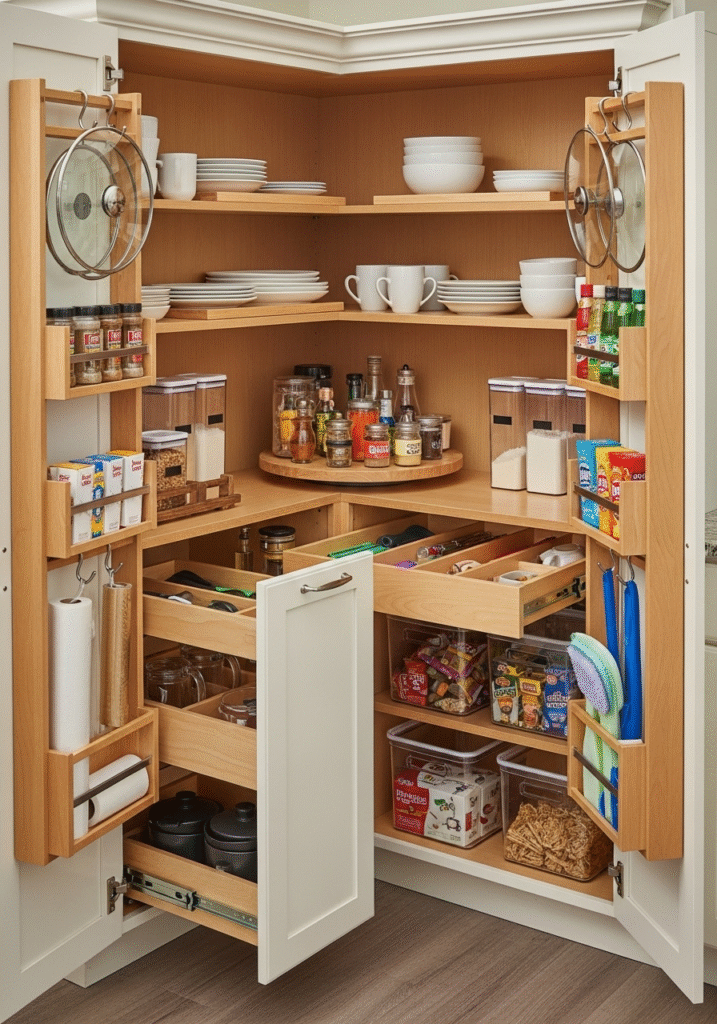
Step 6: Optimize with Functional Layout
Organizing your kitchen cabinets is one thing; keeping them organized day after day is quite another. That’s where a functional, ergonomic layout comes in. By thoughtfully placing your items based on how you use them and how often you reach for them, you create a kitchen environment that’s not only efficient but also comfortable and safe to work in. The goal is to reduce unnecessary movement, minimize bending or stretching, and make cooking and cleaning as smooth as possible.
Why Layout Optimization Matters
A well-optimized kitchen layout is about workflow and accessibility. It anticipates your natural motions during cooking and cleanup and arranges everything accordingly. This kind of organization saves you time and energy and reduces the risk of accidents like knocking over heavy pots or straining to reach frequently used spices.
How to Design Your Functional Layout
- Eye-Level Storage for Everyday Essentials:
Keep your most frequently used items—like everyday mugs, plates, glasses, and favorite snacks—right at eye level. This makes grabbing your morning coffee mug or a quick snack effortless. Placing these items within easy sight and reach streamlines your daily routine and reduces kitchen frustration. - Under-Counter and Base Cabinets for Heavy and Bulky Items:
Pots, pans, bakeware, and heavier small appliances belong in lower cabinets where you can easily lift them out without awkward reaching. These sturdy, spacious cabinets are perfect for items you don’t need constantly but still want accessible when cooking. - High Shelves for Specialty or Seasonal Items:
Fine china, holiday platters, or rarely used gadgets can be stored safely on higher shelves. Since you access these items infrequently, it’s okay to put them out of everyday reach—just make sure you have a safe step stool handy if needed. - Near the Sink for Cleaning Supplies:
Position dish soaps, sponges, scrubbers, and cleaning sprays in the cabinets or drawers closest to your sink or dishwasher. This logical placement ensures that cleanup is quick and efficient, with all your tools right where you need them. - Close to the Cooktop for Cooking Essentials:
Items like cooking oils, salt, pepper, frequently used utensils, and pot holders should be within arm’s reach of your stove and oven. Having these essentials nearby makes seasoning and stirring seamless, helping you stay focused on the cooking process.
Ergonomics and Safety Benefits
An ergonomic layout isn’t just about convenience—it also helps reduce strain and the risk of accidents. Less bending and reaching means less fatigue and fewer chances of dropping or knocking over kitchenware. When heavy pots are stored low and lightweight everyday items are kept easily accessible, you create a safer kitchen environment for yourself and anyone else cooking with you.
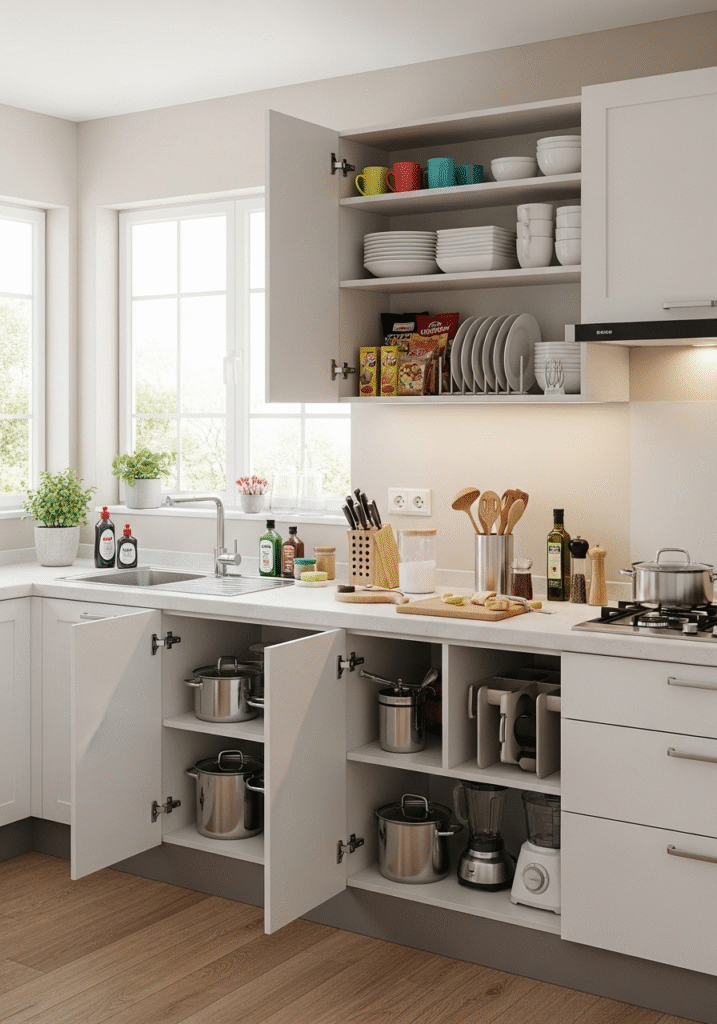
Step 7: Labeling System
One of the simplest yet most effective ways to maintain a tidy, efficient kitchen cabinet system is to implement a clear labeling system. Labels act like friendly reminders that help everyone in your household know exactly where things belong—and just as importantly, where to find them. Whether you live alone or have a busy family, labeling reduces guesswork, speeds up meal prep, and prevents items from wandering into the wrong spots.
Why Labeling Is a Game Changer
Even the most meticulously organized kitchen can fall back into chaos if items aren’t clearly identified. Labels bring clarity and order, transforming your cabinets and pantry into an intuitive system that almost runs itself. When everyone knows exactly where to return items, it’s easier to keep things neat, reduce clutter, and avoid duplicates.
Labels are especially useful for:
- Containers and Jars where contents aren’t visible or may look similar
- Baskets and Bins holding grouped items like snacks or baking supplies
- Cabinet Doors and Shelves to clearly define zones and storage areas
How to Label Effectively
- Clear Jars and Containers:
Label the contents—such as “Quinoa,” “Chickpeas,” or “Brown Sugar”—and include best-before or expiration dates if possible. This helps you use ingredients in the right order and avoid food waste. - Bins and Baskets:
Use labels on containers that group similar items together, like “Snacks,” “Boxed Mixes,” “Kids’ Lunch Supplies,” or “Coffee & Tea.” This makes it easy to quickly grab what you need without opening every basket. - Cabinet Doors and Shelves:
For an extra layer of organization, place labels on the inside or outside of cabinet doors to identify zones, such as “Baking,” “Dinnerware,” “Spices,” or “Cleaning Supplies.” This visual cue keeps zones distinct and helps everyone maintain order.
Choosing the Right Labels
For a polished, lasting look, select weather-resistant, waterproof labels that won’t fade or peel in the humid kitchen environment. Many people love using a label maker with clean, consistent fonts—it’s quick to use and produces professional-looking labels that elevate your kitchen’s style.
If you prefer a DIY vibe, neat handwritten labels on sturdy adhesive paper or chalkboard labels with a chalk marker can add a charming personal touch.
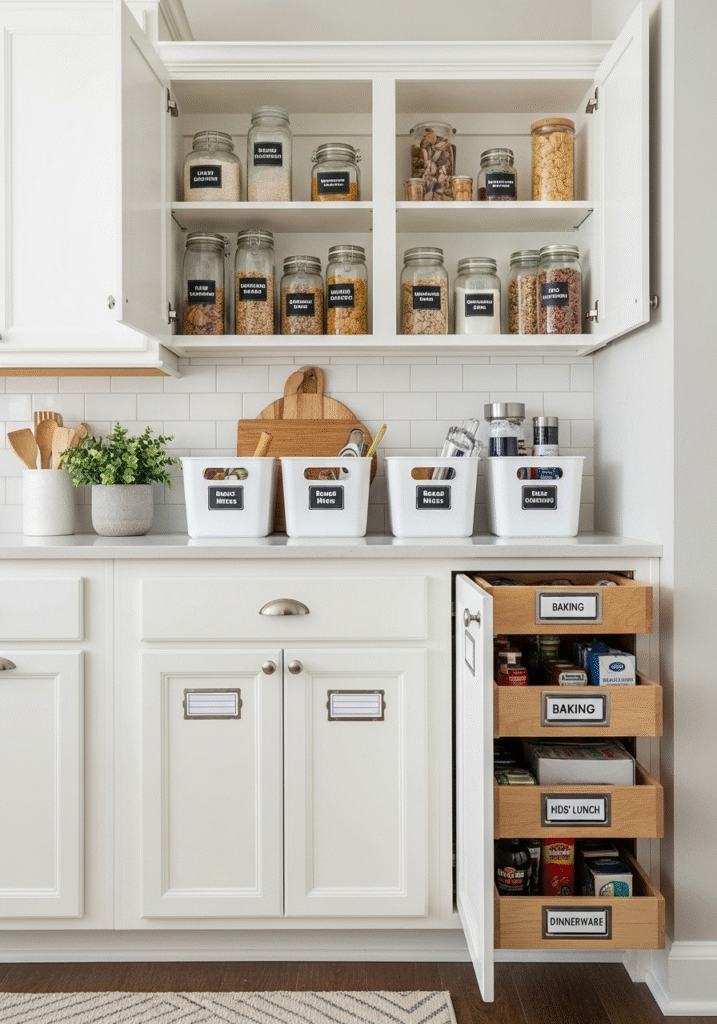
Step 8: Maintain Visibility & Accessibility
An organized kitchen cabinet system isn’t just about putting things in order once—it’s about creating a space that stays neat, easy to use, and efficient every day. The secret to long-term success lies in maintaining visibility and accessibility. If you can’t quickly see or easily reach your items, your organization system will start to break down, leading to frustration and clutter.
Why Visibility and Accessibility Matter
Think about the last time you rummaged through a crowded cabinet or pantry looking for a spice jar or Tupperware lid. It’s exhausting and wastes time. When your kitchen tools and ingredients are clearly visible and easy to access, you save time, reduce stress, and can even cut down on food waste because you know exactly what you have.
Good visibility helps you avoid buying duplicates or forgetting about items hidden at the back of shelves. Accessibility means you don’t have to shuffle things around or bend awkwardly to get what you need—making cooking and cleaning more enjoyable.
How to Maintain Visibility
- Use Transparent Containers:
Storing pantry staples, snacks, and even leftovers in clear containers lets you instantly identify contents without opening lids or guessing. This visual cue speeds up meal prep and keeps your inventory in check. - Choose Open Bins or Baskets:
Open storage bins showcase all the items inside at a glance. Group similar items—like baking supplies or kids’ lunch essentials—together so you can grab what you need quickly without digging. - Utilize Door Organizers:
Maximize space and visibility by installing organizers on the inside of cabinet doors. These are perfect for storing wraps, cutting boards, spice packets, or small utensils. Door organizers keep these items out of the way but within easy reach.
How to Maintain Accessibility
- Assign a “Home” for Every Item:
Establish a specific spot for each kitchen item, and make it a habit to return things to their designated places immediately after use. This simple routine prevents clutter build-up and makes tidying up faster and easier. - Keep Frequently Used Items Within Easy Reach:
Store everyday dishes, utensils, and cooking tools where you can access them without stretching or bending. Items used less often can be placed on higher shelves or in less accessible cabinets. - Use Pull-Out Drawers and Lazy Susans:
These storage tools not only help with organization but improve accessibility by bringing the contents of deep cabinets to you with a simple pull or spin.
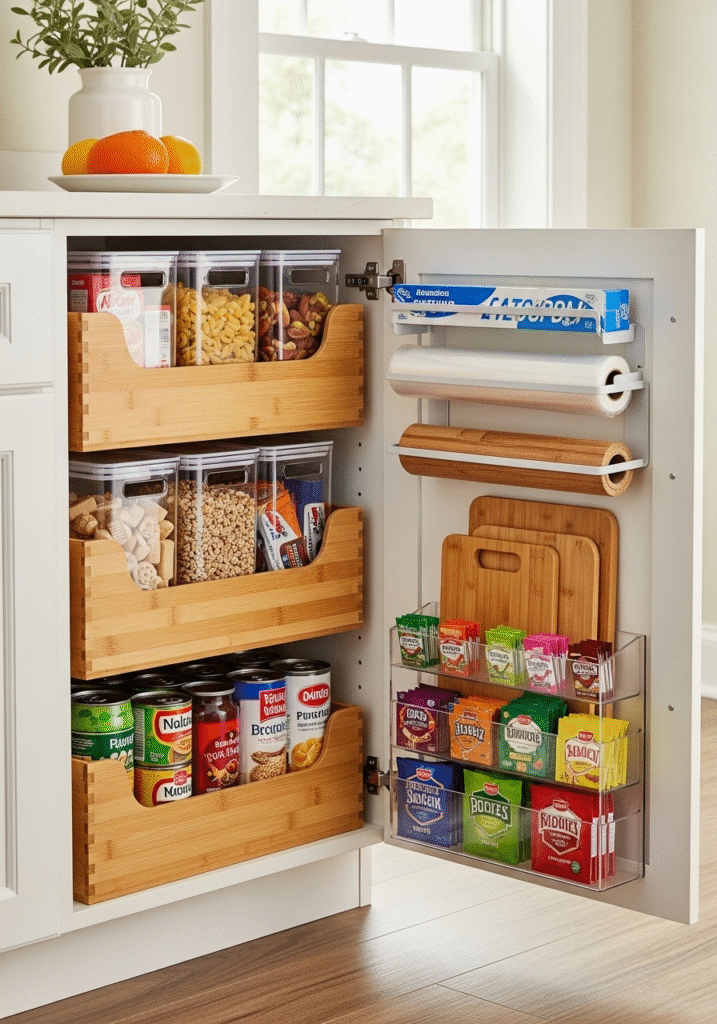
Step 9: Daily & Weekly Maintenance Habits
Creating a beautifully organized kitchen cabinet system is just the beginning. The real challenge is maintaining that order day after day without feeling overwhelmed or letting clutter creep back in. The key to lasting organization is developing simple, consistent maintenance habits that keep your space tidy and functional with minimal time and effort.
Why Maintenance Habits Matter
No matter how well you organize your kitchen, daily use means things will shift, spills may happen, and clutter can build up if not managed regularly. Without a maintenance routine, you risk losing control of your system and facing a time-consuming, stressful overhaul down the line. On the other hand, small, consistent efforts make it easy to sustain your ideal kitchen environment and keep it enjoyable to use.
Daily Habits for a Smooth Kitchen Flow
- End-of-Day Reset:
Make it a habit to spend a few minutes each evening putting away stray dishes, containers, and utensils. Return items to their designated “homes” so the kitchen starts fresh every morning. This small ritual prevents clutter from piling up and makes mornings more pleasant. - Quick Visual Scan:
Glance through your cabinets and pantry daily or every couple of days to check for anything out of place or nearly empty. Catching these little issues early helps you avoid bigger messes later.
Weekly Habits for Deep Refreshing
- Weekly Expiry Check:
Once a week, take a few minutes to scan your spices, snacks, and pantry staples for expired or stale items. Removing these keeps your kitchen fresh and helps prevent unpleasant surprises in your meals. - 20-Minute Weekend Check-In:
Set aside about 20 minutes during the weekend for a quick “tidy-up” session. Straighten shelves, wipe down any surfaces that need attention, reorganize any items that have shifted, and handle minor clutter before it becomes overwhelming. This short, focused time investment keeps your kitchen running smoothly all week long.
Benefits of Consistent Maintenance
By embedding these simple daily and weekly habits into your routine, you maintain control over your kitchen without stress or frustration. These habits help you:
- Save time in the long run by preventing messes
- Avoid the need for major, disruptive cleanouts
- Keep your kitchen inviting and functional every day
- Support your overall wellbeing by creating a calm, orderly environment
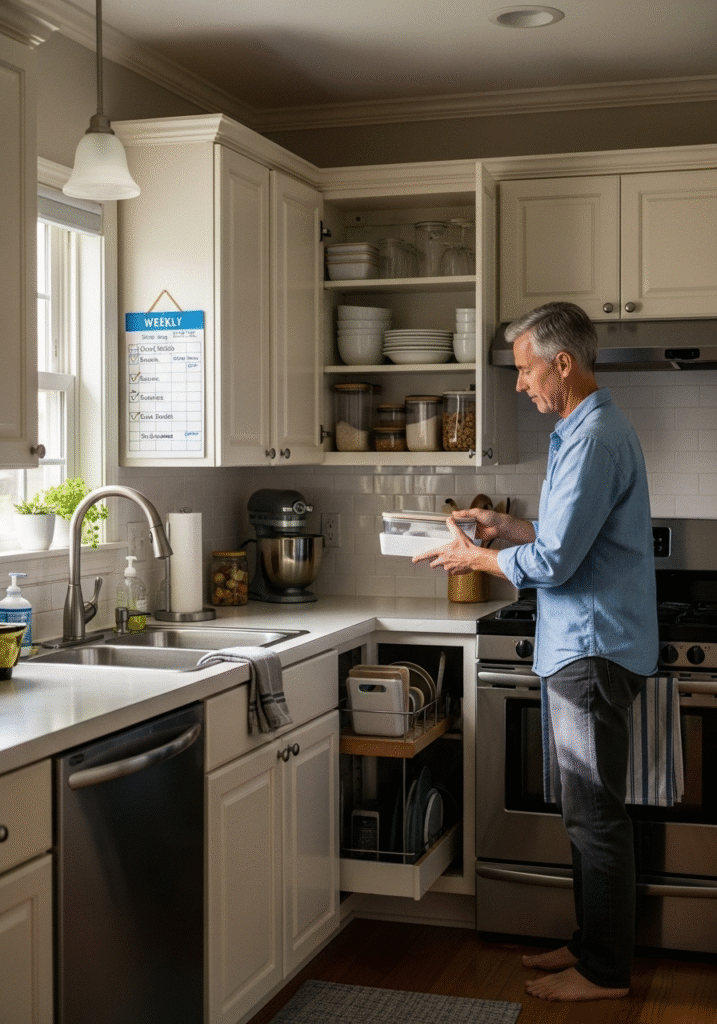
Step 10: Seasonal & Monthly Deep Checks
Maintaining an organized kitchen is an ongoing process that benefits from regular, deeper reviews beyond daily and weekly upkeep. Every month or season, dedicating time to deep checks ensures your kitchen stays in top shape, adapts to your changing needs, and continues to function efficiently throughout the year.
Why Deep Checks Are Essential
Even the best organization systems can become less effective if they stay static while your lifestyle and habits evolve. Seasonal changes in cooking routines, new appliances or tools, and shifting food preferences all mean your kitchen needs a fresh look periodically. Regular deep checks help you:
- Clear out expired or unwanted items
- Refresh your layout to match how you use your kitchen now
- Replace or upgrade storage tools for optimal performance
- Avoid clutter buildup and maintain a clean, efficient space
What to Focus on During Your Deep Checks
- Pantry and Expiry Inspection:
Go through your pantry and cupboards thoroughly every few months. Toss out expired sauces, baking ingredients past their prime, and snacks that have been forgotten. This not only frees up space but ensures the food you use is fresh and safe, helping reduce waste. - Re-evaluate Your Layout:
Consider how your cooking habits change with the seasons. For example, in summer, you might use grilling tools more often and want those items easily accessible, while winter might call for more baking supplies upfront. Adjust your cabinet zones accordingly to keep your kitchen aligned with your lifestyle. - Reassess Your Storage Tools:
Over time, storage tools like Lazy Susans, shelf risers, or bins may wear out or no longer fit your needs perfectly. Check if any need replacing or upgrading to keep your cabinets functioning smoothly. Maybe you’ve acquired new gadgets that require different storage solutions, or you want to try a more modular system. - Clean and Refresh:
Use this time to wipe down shelves and cabinet interiors, replace worn liners, and generally refresh the space so it stays hygienic and pleasant to use.
Benefits of Seasonal and Monthly Reviews
Taking this extra time periodically prevents small issues from snowballing into major clutter or disorganization. It keeps your kitchen evolving with you, reflecting your current habits, tastes, and needs. This proactive approach not only saves you time and stress but also enhances your overall cooking experience by ensuring your kitchen is always set up to support you in the best way possible.
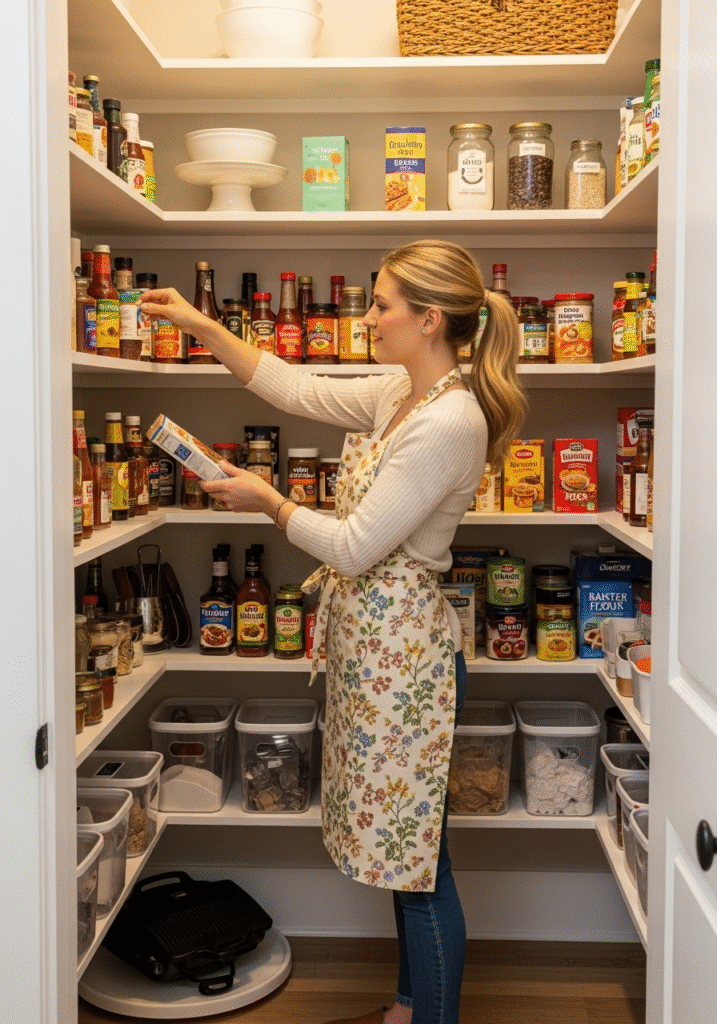
Bonus Tips & Common Mistakes
As you embark on organizing your kitchen cabinets, a few extra tips and awareness of common mistakes can make all the difference between a cluttered mess and a smoothly functioning space. These bonus insights help you fine-tune your system and avoid the traps that often undermine even the best efforts.
Avoid Overstuffing Cabinets
One of the most frequent mistakes in kitchen organization is cramming too many items into a cabinet or drawer. While it’s tempting to pack every inch of space, leaving some breathing room is crucial. For example, when storing plates or bowls, ensure there’s enough space to comfortably take one out without knocking over others. Overstuffed cabinets quickly become frustrating, messy, and harder to maintain. Aim for balance—maximize space but keep access easy and smooth.
Use Cabinet Doors Wisely
The inside of cabinet doors is prime real estate often overlooked. Installing small hooks, racks, or bins on these doors provides additional storage for often-misplaced items like pot lids, plastic wraps, foil, or small utensils. This approach frees up shelf space and keeps these essentials within easy reach. It’s a smart way to add storage without cluttering your main cabinet areas.
Utilize Vertical Space Fully
Many kitchens waste valuable vertical space by stacking items inefficiently or not at all. Using shelf risers, stackable bins, or adding extra shelving can double or even triple your storage capacity. Make use of your cabinet height by stacking plates, bowls, or containers safely, and ensure that everything remains stable and accessible. Vertical storage unlocks potential in cabinets that seem too small on the surface.
Watch for Hidden Clutter
Boxes inside boxes or unlabeled containers can hide clutter that slowly accumulates out of sight. It’s easy to forget what’s in the back of a cabinet when things aren’t clearly labeled or grouped. Regularly inspect these hidden spots, and use clear bins or labels to keep everything visible. This prevents forgotten items from taking up valuable space and keeps your kitchen inventory accurate.
Avoid One-Size-Fits-All Solutions
Every kitchen and cook is unique. What works perfectly for one person might not suit another’s habits or lifestyle. Customize your cabinet organization based on your own cooking style. If you bake frequently, dedicate more space and priority to your baking gear and ingredients. If you cook large meals or entertain often, arrange your cookware and serving dishes accordingly. Tailoring your system to your routines ensures it works for you, not against you.
